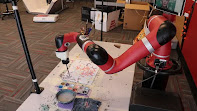This AI-Powered Robot Arm Collaborates With Humans to Create Unique Paintings
A new AI robotic arm was created to paint compelling artwork and is now coming to the forefront as a revolutionary entity. FRIDA (Framework and Robotics Initiative for Developing Arts) is a robotic arm created at Carnegie Mellon University’s School of Computer Science and is the newest addition to the university’s art world.
The AI arm is named after iconic Mexican painter Frida Kahlo, and can collaborate with humans to create works of art, Aaron Aupperlee, Senior Director of Media Relations, said in a letter shared with Gizmodo.
FRIDA’s creation was conducted by Peter Schaldenbrand, a Ph.D. student at the School of Computer Science alongside faculty members Jean Oh and Jim McCann.
Aupperlee shared FRIDA’s works of art with Gizmodo along with photos of FRIDA’s paintings.
Click through to see FRIDA’s artistic process.
FRIDA takes about an hour to learn how to use the paintbrush and specific brush strokes before creating the art—which is done by humans sending a text description or by the user uploading a photo to inspire its style. Schaldenbrand and the FRIDA team are also testing music as a directive, such as ABBA’s song, Dancing Queen.
Although FRIDA’s artwork is impressive, Schaldenbrand cautioned in a press release sent to Gizmodo, “FRIDA is a robotic painting system, but FRIDA is not an artist.”
“FRIDA is not generating the ideas to communicate. FRIDA is a system that an artist could collaborate with. The artist can specify high-level goals for FRIDA and then FRIDA can execute them.”

Comments
Post a Comment